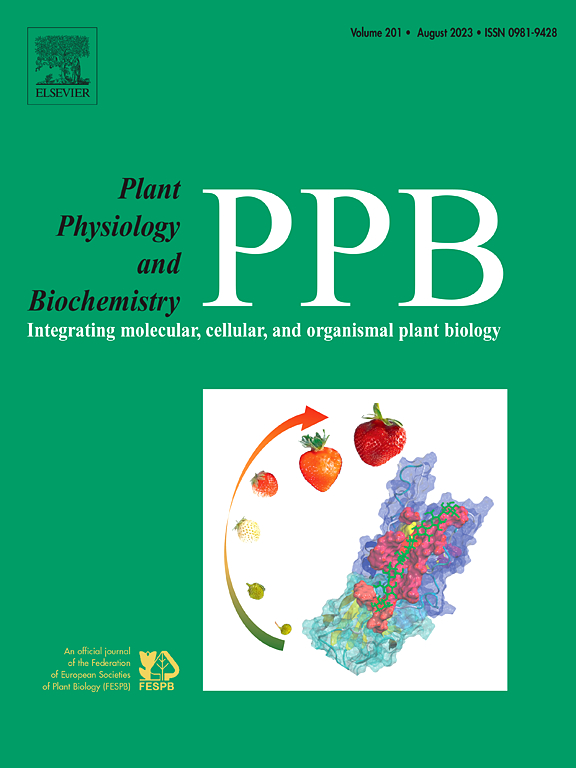S-RNase-mediated attenuation of FviPP2Ac-FviRbohH binding promotes ROS accumulation and arrests pollen tube growth in Fragaria viridis
IF 6.1
2区 生物学
Q1 PLANT SCIENCES
引用次数: 0
Abstract
Fragaria viridis exhibits S-RNase-based gametophytic self-incompatibility (SI), which is governed by a polymorphic S-locus including two S-RNase alleles along with multiple S-locus F-box (SLF) genes. However, SI reaction in flowers triggers a complex cascade involving numerous genes unlinked to S-locus, the mechanisms underlying their mediation of SI response remain unclear. In this study, a phosphatase FviPP2Ac and a NADPH oxidase FviRbohH were observed to highly express in pollen and relate to reactive oxygen species (ROS) and SI response. Self-pollen tubes exposed to S-RNase exhibited downregulation of FviPP2Ac and upregulation of FviRbohH. FviPP2Ac played a negative role in pollen tube growth, as supplying FviPP2Ac protein with pollen culture resulted in inhibited pollen tube elongation and reduced ROS content at pollen tube tips. Conversely, FviRbohH acted as a positive regulator, since knockdown of FviRbohH expression in pollen using antisense oligodeoxynucleotides (as-ODN) led to growth suppression, accompanied by decreased ROS levels at pollen tube tips. FviPP2Ac bound to S-RNase in an S-haplotype-independent manner, whereas no interaction was detected between FviRbohH and S-RNase. FviPP2Ac interacted with FviRbohH and inhibited its activity, while S-RNase weakened this interaction without S-haplotype selectivity. Furthermore, we proposed a S-RNase-FviPP2Ac-FviRbohH-ROS signaling pathway model, which provides new clue for revealing a regulatory mechanism about ROS production in SI response of self-pollination in Fragaria viridis.
s - rnase介导的FviPP2Ac-FviRbohH结合的衰减促进了ROS的积累并抑制了花粉管的生长
紫堇具有基于S-RNase的配子体自交不亲和性(SI),该配子体自交不亲和性是由包含两个S-RNase等位基因和多个S-locus F-box (SLF)基因的多态性s位点控制的。然而,花中的SI反应触发了一个复杂的级联反应,涉及许多与s位点无关的基因,其介导SI反应的机制尚不清楚。在本研究中,我们观察到磷酸酶FviPP2Ac和NADPH氧化酶FviRbohH在花粉中高表达,并与活性氧(ROS)和SI反应有关。暴露于S-RNase的自花粉管表现出FviPP2Ac的下调和FviRbohH的上调。FviPP2Ac对花粉管生长起负向作用,在花粉培养中提供FviPP2Ac蛋白会抑制花粉管伸长,降低花粉管尖端的ROS含量。相反,FviRbohH作为正调节因子,因为使用反义寡脱氧核苷酸(as- odn)敲低花粉中FviRbohH的表达导致生长抑制,并伴随着花粉管尖端ROS水平的降低。FviPP2Ac以独立于s -单倍型的方式与S-RNase结合,而FviRbohH与S-RNase之间未检测到相互作用。FviPP2Ac与FviRbohH相互作用,抑制其活性,而S-RNase削弱了这种相互作用,没有s -单倍型选择性。此外,我们还建立了S-RNase-FviPP2Ac-FviRbohH-ROS信号通路模型,为揭示花椰菜自花授粉SI响应中ROS产生的调控机制提供了新的线索。
本文章由计算机程序翻译,如有差异,请以英文原文为准。
求助全文
约1分钟内获得全文
求助全文
来源期刊
CiteScore
11.10
自引率
3.10%
发文量
410
审稿时长
33 days
期刊介绍:
Plant Physiology and Biochemistry publishes original theoretical, experimental and technical contributions in the various fields of plant physiology (biochemistry, physiology, structure, genetics, plant-microbe interactions, etc.) at diverse levels of integration (molecular, subcellular, cellular, organ, whole plant, environmental). Opinions expressed in the journal are the sole responsibility of the authors and publication does not imply the editors'' agreement.
Manuscripts describing molecular-genetic and/or gene expression data that are not integrated with biochemical analysis and/or actual measurements of plant physiological processes are not suitable for PPB. Also "Omics" studies (transcriptomics, proteomics, metabolomics, etc.) reporting descriptive analysis without an element of functional validation assays, will not be considered. Similarly, applied agronomic or phytochemical studies that generate no new, fundamental insights in plant physiological and/or biochemical processes are not suitable for publication in PPB.
Plant Physiology and Biochemistry publishes several types of articles: Reviews, Papers and Short Papers. Articles for Reviews are either invited by the editor or proposed by the authors for the editor''s prior agreement. Reviews should not exceed 40 typewritten pages and Short Papers no more than approximately 8 typewritten pages. The fundamental character of Plant Physiology and Biochemistry remains that of a journal for original results.

 求助内容:
求助内容: 应助结果提醒方式:
应助结果提醒方式:


